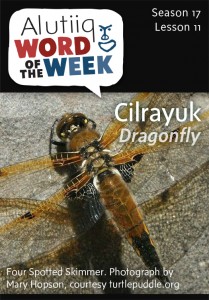Cilrayuk alingtaakait. – They used to be afraid of the dragonfly.
Did you know that Alaska has an official insect? In 1995, the state’s school children awarded the dragonfly this special honor. The four-spotted skimmer (Libellula quadrimaculata) took the prize. Like the other 30 species of dragonflies in Alaska, this insect can eat up to 600 flies or mosquitos a day and it is a spectacular flier.
Dragonflies have lived on Earth for 300 million years. Hatched from eggs laid in the water, they are powerful predators. As nymphs they gobble up water insects before climbing out of ponds and taking to the air. As adults they use their flying prowess to hunt. Dragonflies can fly backward, upside down, and as much as 40 miles per hour. They can also stop suddenly and hover. In the contemporary Alutiiq language, the term for helicopter takes its name from the dragonfly. Helicopters are known as cilrayuguaq or “like a dragonfly.”
The dragonfly is Kodiak’s largest flying insect. While the island’s cold, windy weather can be tough on these insects, lakes and ponds help dragonflies thrive. Here the temperature is warmer. As such dragonflies are a dominant predator in local ponds, where they eat other insects and even fish fry. Nymphs may live for up to 6 years in water, but once they take to the air, adult dragonflies live about two months.
Among the Tlingit dragonflies are thought to transport human souls for shamans. They are symbols of transformation and often represented in Tlingit art. Alutiiq people may have seen a similar connection between dragonflies and the spirit world, given that many Alutiiq Elders consider dragonflies to be highly dangerous. As children, they were taught to avoid these insects.

